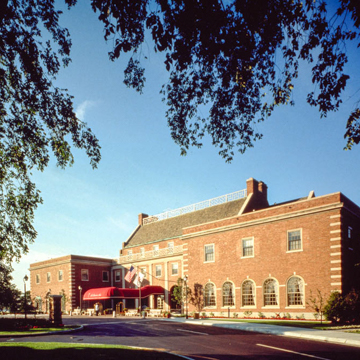Like the Henry Ford Museum and Greenfield Village ( WN135), the Dearborn Inn and Colonial Homes were designed as a small American village. They accommodate visitors to The Henry Ford, some of whom once arrived by air at the Henry Ford Airport, now closed. The red brick Adamesque inn was erected in 1931 to the plans of Kahn. In 1937–1938 additional rooms were needed. Hart of New York City, architect for the L. G. Treadway Service Corporation of New York who managed the inn, convinced the Ford family, the owners, to build reproduction historical houses behind the inn rather than an addition to the inn. Plans called for a “colonial village development” of eighteen historic guest houses in keeping with Greenfield Village, which would be arranged around a swimming pool, tennis courts, and manager's house. Only five of the houses were built. They are the houses of Walt Whitman, Edgar Allen Poe, Oliver Wolcott, Barbara Fritchie, and Patrick Henry. Hart reproduced the Henry house from Lost Examples of Colonial Architecture (1931). He replicated the other four based on archival records and from measured drawings of the houses that still stood. The exteriors are true to the original houses, but the interiors are arranged to accommodate bedrooms, bathrooms, kitchenettes, and parlors. The houses are furnished with reproductions of Early American furniture manufactured by Virginia Craftsmen of Harrisonburg. There were large additions to the inn in 1989.
You are here
Dearborn Inn and Colonial Homes
1931 inn, Albert Kahn; 1937 homes, Charles T. Hart of Hart and Shape; Marshall L. Johnson, landscape architect. 20301 Oakwood Blvd.
If SAH Archipedia has been useful to you, please consider supporting it.
SAH Archipedia tells the story of the United States through its buildings, landscapes, and cities. This freely available resource empowers the public with authoritative knowledge that deepens their understanding and appreciation of the built environment. But the Society of Architectural Historians, which created SAH Archipedia with University of Virginia Press, needs your support to maintain the high-caliber research, writing, photography, cartography, editing, design, and programming that make SAH Archipedia a trusted online resource available to all who value the history of place, heritage tourism, and learning.















